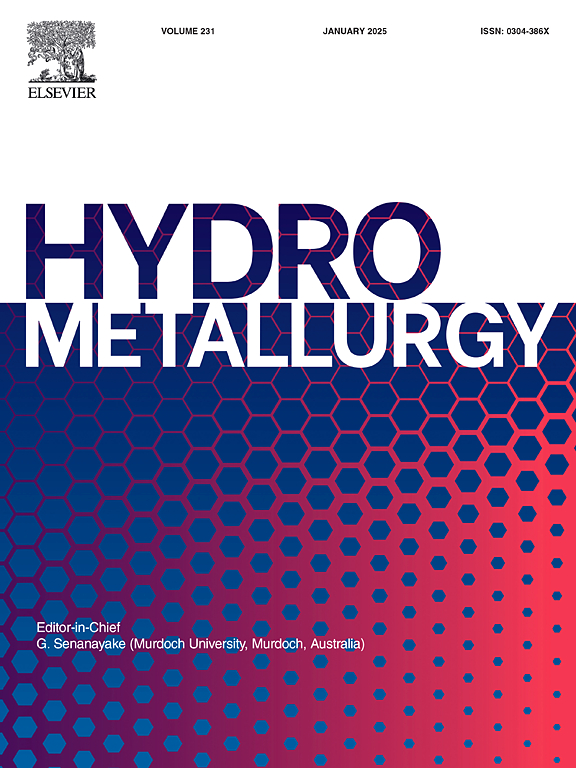Microwave-induced modifications in electric arc furnace slag: An attempt to enhance aqueous dissolution
IF 4.8
2区 材料科学
Q1 METALLURGY & METALLURGICAL ENGINEERING
引用次数: 0
Abstract
Electric arc furnace slag (EAFS) is produced in large amounts during steel manufacturing and can pose ecological hazards when disposed of in nature. Its heterogeneity, intricate mineralogy, and low solubility restrict its applicability in numerous fields, such as cementitious binders, resource recovery, and mineralization. This study investigated three different microwave irradiation techniques—direct (MWD), roasting with NaOH (MWR), and solution (MWS)—to modify the EAFS and exceed the current boundaries. The former involved direct exposure of EAFS (D90: <30 μm) to microwaves, while the latter included a mixed of EAFS and NaOH, followed by microwave roasting. Both microwave-irradiated samples were later dissolved via stirring in aqueous conditions at a 1:100 g/mL ratio. In contrast, MWS comprised dissolution of EAFS in water under microwave irradiation in a closed vessel. The elemental releases were then analyzed using an inductively coupled plasma-optical emission spectrometer. Structural, surface chemistry, and morphology examinations were also conducted. The results indicated that the structural alterations directly influenced release of Al, leading to a dissolution extent of 25 % for MWR, in contrast to the reference, which attained only 10 %. The release of Si was only achieved using MWR, reaching 3 %. The release of Ca was prominent in the MWS, achieving the highest concentration relative to the others and exhibiting 50 % enhancement. The findings obtained by surface and solution chemistry and microstructural images supported the differences in elemental releases among sample series following microwave irradiation. In conclusion, this study demonstrated the promising potential of microwave irradiation to enhance the dissolution of EAFS, providing more insights into its appropriate applications and valuable reuse.
微波诱导的电弧炉炉渣改性:增强水溶的尝试
电弧炉渣是钢铁生产过程中产生的大量炉渣,在自然环境中处理会造成生态危害。它的非均质性、复杂的矿物学和低溶解度限制了它在胶结粘合剂、资源回收和矿化等许多领域的适用性。研究了直接微波(MWD)、氢氧化钠焙烧(MWR)和溶液微波(MWS)三种不同的微波辐照技术,以改进EAFS并超越现有的边界。前者是将EAFS (D90: <30 μm)直接暴露在微波中,而后者是将EAFS和NaOH混合,然后进行微波焙烧。两种微波辐照的样品随后以1:100 g/mL的比例在水溶液中搅拌溶解。相比之下,MWS是在密闭容器中微波照射下EAFS在水中的溶解。然后使用电感耦合等离子体光学发射光谱仪分析元素释放。还进行了结构、表面化学和形态学检查。结果表明,结构改变直接影响Al的释放,导致MWR的溶出度为25%,而参考材料的溶出度仅为10%。硅的释放率只有MWR才能达到3%。Ca的释放在MWS中表现突出,相对于其他物质,Ca的释放达到最高浓度,并表现出50%的增强。表面化学和溶液化学以及显微结构图像的发现支持了微波辐照后不同样品系列元素释放的差异。综上所述,本研究证明了微波辐射增强EAFS溶解的潜力,为其合理应用和有价值的再利用提供了更多的见解。
本文章由计算机程序翻译,如有差异,请以英文原文为准。
求助全文
约1分钟内获得全文
求助全文
来源期刊

Hydrometallurgy
工程技术-冶金工程
CiteScore
9.50
自引率
6.40%
发文量
144
审稿时长
3.4 months
期刊介绍:
Hydrometallurgy aims to compile studies on novel processes, process design, chemistry, modelling, control, economics and interfaces between unit operations, and to provide a forum for discussions on case histories and operational difficulties.
Topics covered include: leaching of metal values by chemical reagents or bacterial action at ambient or elevated pressures and temperatures; separation of solids from leach liquors; removal of impurities and recovery of metal values by precipitation, ion exchange, solvent extraction, gaseous reduction, cementation, electro-winning and electro-refining; pre-treatment of ores by roasting or chemical treatments such as halogenation or reduction; recycling of reagents and treatment of effluents.
 求助内容:
求助内容: 应助结果提醒方式:
应助结果提醒方式:


